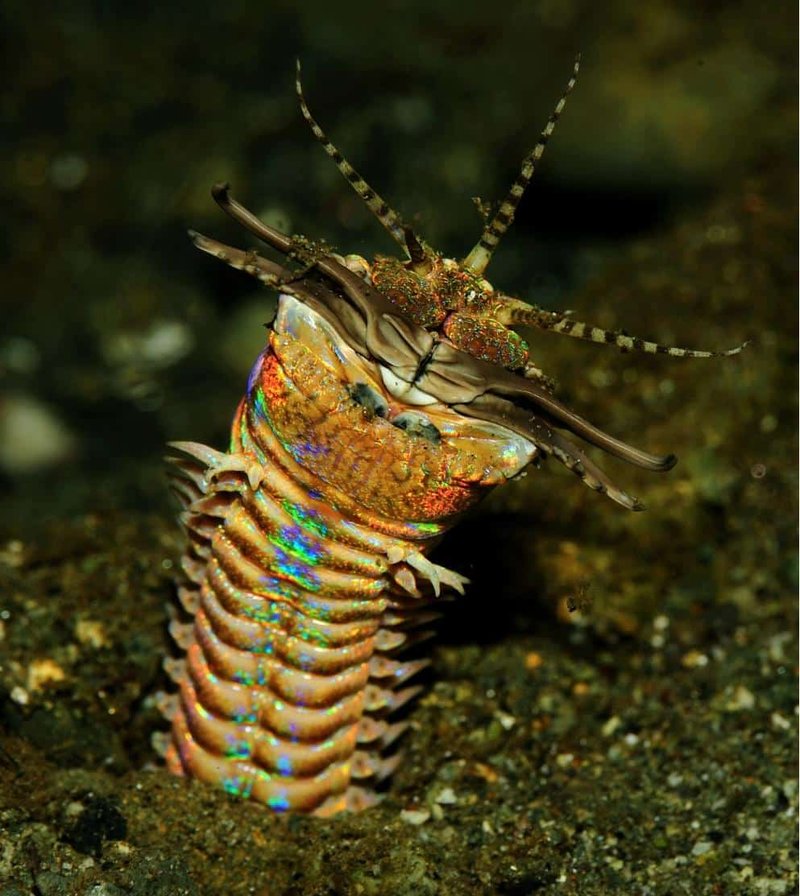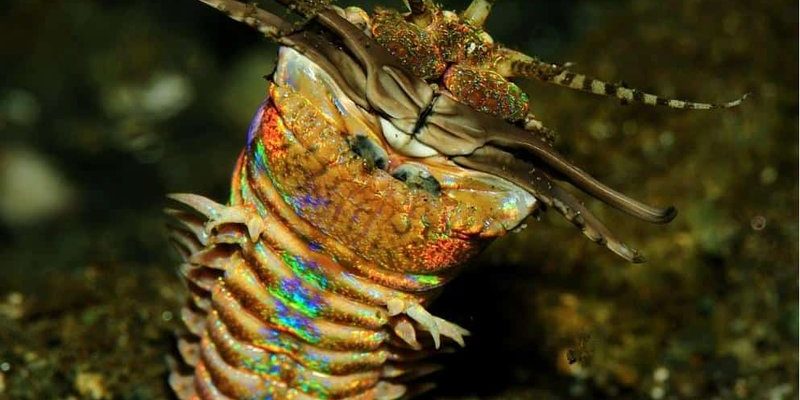
But what exactly are polychaete worms? They’re a large group of segmented worms that live in marine environments, and they come in various shapes, sizes, and behaviors. So, how does the Bobbit worm stack up against other polychaete species? In this blog post, we’ll explore the unique features of Bobbit worms and compare them to other polychaete worms. You’ll get a clearer picture of what makes these underwater dwellers tick, and who knows, you might leave with a newfound appreciation for these magnificent creatures.
What is a Bobbit Worm?
Bobbit worms, or *Eunice aphroditois*, are eye-catching and somewhat terrifying. They’re often found in coral reefs and sandy ocean bottoms, where they hide in burrows. Their striking trait? A set of powerful jaws that can snap shut at lightning speed. These worms primarily feed on fish and other marine life, using their formidable jaws to catch unsuspecting prey.
One of the most fascinating aspects of the Bobbit worm is its length. They can reach up to 10 feet in size, making them one of the largest polychaete worms out there. Their elongated body is covered in bristles called setae, which help them navigate through their marine habitats. Picture a giant spaghetti strand lurking beneath the ocean floor, ready to pounce on anything that gets too close. That’s the Bobbit worm in action!
Interestingly, the Bobbit worm has been the inspiration for various myths and legends. In popular culture, it’s often dubbed the “creature from the deep,” and many people get a little creeped out just hearing about it. Honestly, the idea of a worm with such fierce hunting skills might raise some eyebrows. But fear not; these worms are not a danger to humans unless provoked.
A Closer Look at Polychaete Worms
Now, let’s pull back and examine the larger family of polychaete worms. These fascinating organisms are categorized into two main groups: errant and sedentary. Errant polychaetes are your active wanderers, often seen moving around the ocean floor. On the other hand, sedentary polychaetes prefer to stay in one spot, usually tucked into tubes or burrows.
Polychaete worms can be incredibly diverse, boasting over 10,000 species! Their habitats range from deep sea trenches to shallow coastal waters. The incredible variety means they have adapted to thrive in different environments. For instance, some polychaetes have brightly colored bodies to attract mates, while others blend seamlessly with their surroundings to avoid predators.
These worms play a crucial role in marine ecosystems. They’re not just fascinating to look at; they’re also essential for the health of ocean environments. Polychaetes help break down organic material, contributing to nutrient cycling. When you think about it, they’re like nature’s little recyclers, cleaning up and helping other creatures thrive.
Comparing Bobbit Worms to Common Polychaete Species
Now, let’s compare Bobbit worms to a few other common polychaete species, like the feather duster worm and the paddle worm. Each of these creatures showcases different characteristics that highlight the diversity within the polychaete family.
The feather duster worm, for example, has a beautiful crown of feathery tentacles that it uses to filter-feed on plankton. Unlike the Bobbit worm, which actively hunts, feather dusters prefer a more passive lifestyle, waving their tentacles to catch tiny food particles from the water. This difference in feeding strategy represents a notable contrast between species.
On the flip side, there’s the paddle worm, which uses its paddle-like appendages to swim through the water. This species is known for its vibrant colors and swift movements. While Bobbit worms lurk stealthily, paddle worms are like the party animals of the ocean floor, swimming around actively. Their contrasting lifestyles remind us that there’s no one “right” way to be a polychaete worm; they all have their own special skills!
Feeding Habits: Hunter vs. Filter-Feeder
When it comes to feeding, Bobbit worms take on a fierce, predatory role. They are opportunistic hunters, often snatching up fish, shrimp, and other small marine creatures with their powerful jaws. Their strategy is all about patience and speed. They spend time in their burrows, waiting for prey to come within striking distance. When they do, it’s over in a flash—you can liken it to a cat catching a mouse!
In contrast, many polychaetes, like the feather duster worm, employ a more passive eating strategy. Feather dusters extend their feathery crowns to capture tiny plankton drifting in the water. They rely on currents to bring food to them, making their feeding relatively low-key.
This difference in feeding styles also affects their habitats. Bobbit worms prefer deeper areas of the ocean floor where they can conceal themselves and launch surprise attacks. Feather duster worms, however, thrive in shallower waters where they can easily capture drifting food particles. It’s like comparing a stealthy ninja to a graceful dancer—each has its own place in the world.
Defensive Mechanisms: How Do They Protect Themselves?
Every creature has a way to defend itself, and Bobbit worms are no exception. Their primary defense mechanism is their incredible speed during the hunt, which is also used to escape potential threats. Once they’re detected, they quickly retreat into their burrows, out of reach from predators. Plus, their size alone can be quite intimidating for smaller marine creatures.
On the other hand, some polychaete worms use camouflage for protection. For instance, many species can blend in with their surroundings, making it difficult for predators to spot them. Some even have tough, bristly bodies that deter would-be attackers. Imagine a worm that looks just like a piece of coral or sand; it’s a clever survival tactic!
In addition to physical defenses, some polychaetes can even produce toxins. While Bobbit worms are not known for this, certain related species can deter predators with unpleasant chemicals. It’s nature’s way of saying, “Stay away; I’m not as easy to eat as you think!”
Reproduction: Unique Approaches Among Polychaetes
Reproduction in polychaete worms is as diverse as their feeding habits. Bobbit worms are known for their fascinating method of reproduction, which can involve both sexual and asexual processes. In some cases, they can reproduce by fragmentation, where a portion of the worm breaks off and grows into a new individual. This is a bit like a plant growing a new shoot from a cutting!
In contrast, other polychaetes, such as the sandworm, rely heavily on external fertilization. During the breeding season, they release eggs and sperm into the water, allowing fertilization to happen in open water. It’s a bit like a giant free-for-all, where countless eggs are scattered, increasing the chances of some developing into healthy new worms.
The strategies reflect the varying environments these creatures inhabit. Bobbit worms, with their hidden lifestyles, benefit from more controlled reproduction methods, while sandworms take advantage of open water to maximize their reproductive success. It’s a testament to how adaptability is key in the animal kingdom.
As we wrap up this exploration of Bobbit worms and their polychaete relatives, it’s clear that these creatures are more than just simple worms. They play critical roles in marine ecosystems and showcase incredible diversity. From the fierce hunting methods of the Bobbit worm to the passive feeding styles of feather duster worms, there’s a lot to admire.
Understanding these differences not only deepens our appreciation for marine life but also highlights the importance of conserving these ecosystems. Each polychaete species, including the captivating Bobbit worm, contributes to the vibrant tapestry of the ocean. So the next time someone mentions worms, you can share some fascinating facts about these incredible underwater dwellers—and maybe even spark a new curiosity in them!

